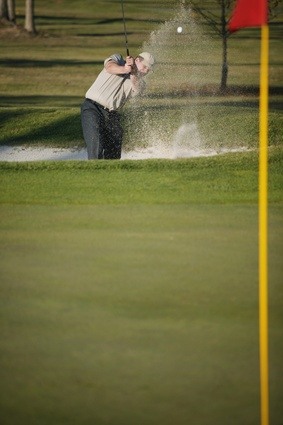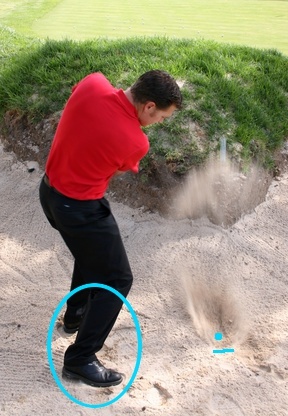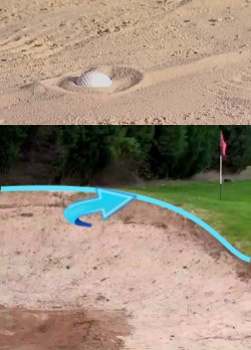
Most amateur golfers would rather visit the dentist than play from a bunker. Gripped with uncertainty, their thoughts swirl from one confounding question to the next: How hard should I swing? Do I hit the ball first, or the sand? How can I lift the ball over the lip?
Professionals, on the other hand, welcome a shot from a clean lie in the sand. Where their amateur counterparts hope to just get the ball out, pros aim to knock it close for a tap-in par. Quite often, they do exactly that.
Even so, pros get up-and-down from bunkers about 50 percent of the time, well below their average from outside the sand.
Why It's Important
If the world's best players have only a 50-50 chance of getting down in two shots out of sand, what are your odds? Considerably less, of course. But that doesn't mean you shouldn't work on your bunker play.
The problem regular golfers face isn't an inability to save par, but the possibility of making a big number. Too many of us fail to escape sand on the first try – and sometimes the second and third. Even worse is the thin shot that sails over the green into bigger trouble.
You can save a lot of strokes simply by learning to get the ball onto the green consistently.
Who You Should Watch
The biggest difference between pros and amateurs when it comes to bunker play? Pros accelerate through the shot, while ams decelerate. An accelerating swing not only powers the ball out, it creates the spin needed to make it stop on the green.
England's Luke Donald is brilliant from the sand, getting up-and-down about 65 percent of the time. K.J. Choi and Brian Gay are remarkably efficient as well.

When pros assess a bunker shot, they pick a landing a spot on the green. Once in the bunker, they follow this procedure:
- Dig feet an inch or so into the sand to provide stability and make sure the club hits behind the ball.
- Open stance and clubface based on the desired height of the shot; more open equals a higher flight.
- Swing with enough length and authority to assure the ball pops out.
- Hit 1-2 inches behind the ball, with the club entering the sand on a shallow angle to prevent leaving the shot short.
Apply It to Your Game
The best approach is to keep things simple. Master the basic technique outlined above and you'll get up and out – without going too far – most every time.

Watch and Learn: Pros Play from Bunkers
As an amateur golfer, you probably live in a bit of fear when it comes to bunkers. You would rather your ball stay as far away from the sand as possible, as you aren't quite confident in your bunker technique. It is easy to just stick with this line of thinking throughout your golf career, but doing so will hold you back. If you open up your mind to the possibility that bunker shots aren't actually all that difficult, you may find that you can use them to your advantage from time to time.
One of the best ways to improve any part of your golf game is to watch professional golf. The pros have a wide range of skills which allow them to deal with any kind of shot that may come up over the course of a round. While pro golfers are better than their amateur counterparts across the board, one area where they really shine by comparison is in the bunkers. When a pro finds his or her ball in a greenside bunker, it usually isn't a problem. They will make an aggressive swing, the ball will pop up nicely into the air, and it will often settle within short range of the hole. So how do they do it? It all comes down to technique, strategy, and experience.
In this article, we are going to discuss how professional golfers approach their bunker shots, and we are going to highlight ways for you to follow their lead. You don't have to just resign yourself to being a poor bunker player for the rest of your time as a golfer – with some hard work and attention to detail, you can turn this weakness into a strength.
No matter what kind of bunker player you may be now, it is certain that you won't improve without practice. Even reading this article isn't going to help you play better bunker shots if you fail to practice your technique on a regular basis. Try to find a golf course near you which offers a practice bunker and use it as often as possible to sharpen your skills. Not only will this kind of practice pay off in a big way on the course, but you may find that you actually enjoy working on this part of your short game.
You aren't going to be able to elevate your bunker play without the right equipment, either. Make sure you have a quality sand wedge in your bag, and keep that club as clean as possible throughout each round. It is easy to leave your sand wedge dirty when you get caught up in the flow of a round, but doing so is going to deteriorate the condition of the club over time. You want the club to be ready to use as soon as you take it from the bag, so always wipe it down after each shot.
All of the content below is based on a right-handed golfer. If you happen to play left-handed, please take a moment to reverse the directions as necessary.

A Rather Simple Technique
Let's jump right in to the technique pros use when playing from the sand. Many amateur golfers are off track on the mechanics of a good greenside bunker shot, and they fail to get the ball out of the sand as a result. As is the case with everything in golf, you want to make these shots as simple as you can. By using basic technique and executing that technique over and over again, you can produce reliable shots from what used to be an intimidating position.
The three keys below are all you need to know when trying to create a reliable bunker swing.
- Make a big swing. If you are playing a standard explosion shot from a greenside bunker, a large swing will be needed in order to produce the power required for success. If you make a small swing – like the swing you would make when chipping, for example – you aren't going to be able to carry the club head through the sand with any kind of power. This should be a full swing motion, just like you would make when hitting an iron shot from back in the fairway. With a big backswing on your side, you can carry plenty of speed down into the sand, and the club will be able to glide through the sand and lift the ball out with ease.
- Play with an open club face. This is an area where most amateur golfers struggle. At address, you need to open up the club face significantly in order to expose all available loft to the ball. While your sand wedge may have around 55* of loft when set square at address, you should turn it open to the point where it has something like 75* or 80*. This point all comes down to the launch angle you want to produce when the ball leaves the ground. Since you almost certainly need to clear some kind of bunker lip in front of you on this shot, laying the face open will maximize loft and allow you to elevate the shot almost immediately. You may need to occasionally move the face back closer to square for longer bunker shots, but most greenside bunker shots will be played with the face laid wide open.
- Flex your knees and widen your stance. You want to have your knees flexed before hitting any bunker shot. With that said, your knees should be flexed even a little deeper than normal when you are in the sand. Also, you should have your feet wider apart than you would for a standard short game shot. Remember, you are going to be swinging the club under the level of the ball, so you want to lower the level of your body accordingly. With your feet wide apart and your knees flexed, your entire body will be set low to the sand and you will have a great chance of escaping the trap on your first swing.
As far as technique is concerned, that's all you need to know. Make a big swing, open up the face of the wedge at address, and set your feet wide apart with plenty of knee flex. As long as you check on those points as you practice, it is almost certain that you will be heading in the right direction.

Making the Right Read
You might have expected the technical section of this article to take up more of your time, but there just isn't that much to worry about with regard to your mechanics. As long as you can hit on the three points highlighted in the previous section, you should be seeing solid results. There may be a few tweaks that you decide to make later on, but those will be subtle. From here on out, it is going to be strategy, along with gaining experience, that allows you to perform at a high level in the sand.
Every golfer knows that it is important to read putts, but did you know that you also need to read your bunker shots? It's true – reading both the lie of the ball in the bunker, and the path that you have from the ball to the hole, will help you make the right decisions in a sand trap. Trying to play wrong shot based on the situation at hand is simply a recipe for disaster. Always respect the lie of the ball and only attempt shots that you truly believe will work.
Some of the keys to reading your bunker shots properly are as follows -
- Checking the depth of the sand. Okay – so you aren't actually allowed to check the depth of the sand by sticking your hand or the club down as far as it will go. But, you can get a pretty good read on the sand just by walking up to your ball. Does it feel like there is only a small amount of sand in the bunker, or do you feel like you are walking on a fluffy beach? With plenty of sand, you can play your standard explosion shot without any concern. However, if there is a lack of sand in the trap, you may need to modify your technique a bit to avoid hitting a thin shot. We will talk more about how you can modify your technique later in this article.
- Evaluating your lie. Once you have a pretty good idea of how much sand is actually in the bunker, you can then look closely at your lie. A good lie will have the ball resting on top of the sand, with nothing around the ball in any direction. A poor lie, on the other hand, is going to have the ball sitting down in the sand at least to some degree. No two lies in the bunker are exactly alike, so you will want to evaluate each bunker shot carefully before deciding on a course of action. You can get away with a standard shot even if the ball is sitting down slightly, but you'll need to make some changes if it is too deep.
- Paying attention to the slope. This is a point which is rather easy to overlook. When you are planning your shot, make sure to note how the ground is sloped beneath your feet, if it is sloped at all. Playing a bunker shot from an upslope will make it easy to get the ball out of the sand, but you might have trouble carrying the shot all the way to the target. On the other hand, hitting from a downslope will make it much harder to get the ball up over the lip and out of the bunker. You should never hit a bunker shot without first thinking about what the slope of the ground is going to mean for your shot.
Think about the condition of the greens. You can't focus all of your attention in the bunkers while in this situation. You also need to think some about what the greens are like on that particular day. Are they hard and fast, or soft and slow? The green conditions are going to dictate what the ball does after it lands, which is something you need to take into account before planning your shot. If you are playing a course with soft greens, you will probably need to fly the ball all the way to the target, as it isn't going to go far after it lands. On the other hand, a course with firm greens will require you to land the ball well short of the hole to allow for some bounce and run.
As you can see, there is a lot to think about before you go ahead and hit a bunker shot. It might be a bit overwhelming to try and keep all of this in mind at first, but you will quickly get more and more comfortable with your bunker checklist as time goes by. Before long, you will naturally be able to observe your lie and the rest of the factors without much of a conscious thought. When you are able to blend reliable technique with an accurate read of the situation, great things are possible.

How to Practice Bunker Shots
Few amateur golfers take the time to practice their bunker shots on a regular basis. With that in mind, it should be no surprise that most golfers struggle from the sand. You can't expect to be good at something in golf if you don't bother to work on it regularly. The first and biggest step you can take toward an improved bunker game is simply committing to spending some practice time in the bunkers at your local golf facility.
Once you decide to invest this time, you will need to make sure you are practicing in the right way. Use the tips below to get the most from your time in the sand.
- Give yourself a variety of lies. Sure, you can probably hit some pretty nice bunker shots in practice if you have a good lie each and every time. But does that emulate what you are going to see in the real world? No – probably not. You are going to draw a variety of different lies from round to round, so you need to make sure your practice sessions reflect that variety. Hit some shots with the ball perched nicely on the top of the sand, while you hit others with the ball buried down halfway or so. Also, try to find some slopes to see how those conditions will affect your performance. The more situations you can expose yourself to in practice, the more shots you will be able to handle on the course.
- Take your time. It isn't going to do you much good to just rifle a bunch of golf balls out of the bunker before calling it a day. You would be much better served to take your time and work through a smaller numbers of balls while putting in maximum effort. Prepare for each practice shot as though it was a shot on the course. Pick out a target, rehearse your swing, pay attention to the details of your stance, and then hit the shot. You aren't going to hit as many shots during your practice session when you opt for this plan, but your efforts will be far more meaningful.
- Experiment with different clubs. You don't have to use your sand wedge for every shot you hit out of the sand. It is going to be the right club for the job in plenty of cases, but that will not always be true. Sometimes, you will want to move up to a lob wedge in order to get maximum height on the shot. Other times, you may even go down to a pitching wedge in order to hit a low, skipping bunker shot. By getting comfortable with a variety of clubs during practice, you will feel free to reach for whichever one happens to be called for when you find your ball in a bunker during your next round.
- Clean up after yourself. This isn't a tip which is going to help you be a better golfer – but it will make you a nicer golfer in the eyes of others at the course. Just as you should do when playing on the course, you should always rake up a practice bunker when you are done. The next golfer who wants to use the trap shouldn't need to clean up after you, so take a few moments to smooth out the sand properly.
There are a lot of parts which go into a complete golf game, and all of them need attention. Working on your driving and putting is great, but it won't get you very far if you fail to round out the rest of your game by working on the various other elements. Bunker play is important, and it is something you can absolutely improve at with practice. Carve out at least a few minutes during each practice session for this vital skill.

Adjusting Your Technique
We mentioned earlier that you might not always be able to use the explosion shot when it a greenside bunker. Usually, this is true when you are playing a shot where there is very little sand sitting below the ball. If you try to hit a blast shot from a thin lie, you will often catch the back of the ball with the leading edge of the club – and you will hit a missile over the green and into the distance. Obviously, that is not a good outcome. So, when sand is at a premium, you will need to adjust your technique to get out of this tough spot.
The best way to play this kind of shot is to square up your club face and play the ball as if you were chipping from the grass. Instead of blasting a lot of sand out of the bunker, you are going to attempt to catch the ball cleanly at impact and chip it onto the green. It takes skill to execute this play, but it may be your only option when a lack of sand makes the explosion shot an impossibility.
The first step to playing this shot is to use the lowest-lofted club possible, while still making sure you are going to get the ball out of the trap. Using a pitching wedge would be ideal, but you can go up to a gap wedge or sand wedge if the design of the bunker dictates that you do so. From there, you are going to keep the face square and swing down through the ball just as though you were chipping. You will use your chipping stance, and you will play the ball slightly back in your stance to promote clean contact.
To give yourself the best possible chance of pulling off this tough shot, you need to keep your head perfectly still. Any premature head movement is going to cause a miss-hit, and the ball might not come out of the trap at all. Despite your nerves when trying to make this work, remain calm and keep your head steady while watching the ball all the way through impact.
There is no doubt that professional golfers make bunker shots look awful easy. They may never quite be that easy for the rest of us, but you can certainly make them easier by mastering proper technique and then practicing that technique on a consistent basis. As time passes, you will gain experience in the bunkers and you will no longer fear them in the same way you once did. We hope that the advice we have offered in this article will be of assistance to you as you work toward a better bunker game. Good luck!






